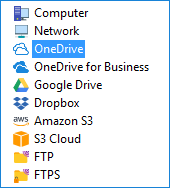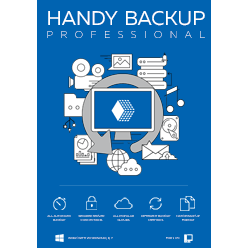How to Choose Best Storage for Backup
Best backup storage must meet some key features, which are perhaps crossing each other or even directly opposing it. Handy Backup allows using any modern type of storage for business and personal purposes, depending of the particular requirements for backups.
Backup Storage Requirements
Let us discuss some most important features of best backup storage solutions for all typical cases.
Storage Space
Most backups are bulky. It has a particular importance with backups of databases, disk images and multimedia collections. Too small size, like a standard free account on a typical cloud service, can be too small to use it for storing multiple backups, especially versioned or rotated copies.
Convenience
No one needs backups when these backups cannot be used in a reasonable time and with reasonable efforts. A fresh backup must be always at hand. Therefore, a backup device unreliable, slow and prone to losing it, such as a DVD disk or a stream tape, are obsolete now.
Speed of Data Copying
Any time used for backup is also a time removed from some other activity. This is a basic principle for not only the “hot” data saving but also for using the speediest, fastest media for keeping big or constantly changing volumes of backups. Note that online storages are slower than offline.
Modern Media for Backup
Despite of the big quantity of different media types, these are the two general data storage types: online and offline storages. Handy Backup supports both these branches, allowing selecting best backup storage online or offline as you wish.
- Online storages can be either local (FTP servers, NAS units and remote disks) or Internet-linked (distant FTPs, cloud services). The Internet connection parameters limit the speed of Internet storages. On the other hand, you can use backup data from Internet from anywhere!
- Offline storages divides into built-in (local PC drives) and removable (USB units, SD or other cards). These units have much bigger operational speed than online media, although may require extra time and efforts to connect or even locate such device.
Advantages and Properties of Different Media Types
Here we provide the list of modern backup storage types, with main features, advantages and, perhaps, problems of each media type.
- Local drives. The most convenient and often the cheapest type of storage, local drives can store all you need for a long time. Disadvantages are unavailability of backups when you are offsite, and the need to replace or rewrite these drives when you upgrade.
- Pluggable USB drives (DAS). A good type of backup storages, capacious and cheap. You can take any of these units off-site when you need, or move it to another machine by just reconnecting it. However, these drives still have no options to connect when you are far away.
- FTP, SFTP and FTPS servers. Links to a local network or attached to Internet with a provided address and/or a name. This storage is typical for static website contents, kiosks and enterprise-level backups. You can access Internet-linked FTPs from anywhere.
- NAS units. Network-linked drives can be just as cheap as external drives and just as readily available as FTP servers can. Therefore, you often can raise a personal cloud service using the NAS software kit, making your backups available via the Internet.
- Commercial clouds. These services provide a full-time access for your backups, but Internet provider settings and other circumstances can compromise connection speed. Despite this fact, clouds are the most convenient and modern way to store data including backups.
- Dedicated vaults. Not any software company provides a secure vault for user backups, although Handy Backup equips a user with an access to S3 cloud types, such as Amazon S3, Box and other services, like Wasabi backup storage.
Where to Back up Your Business Data?

Here are some use cases for typical business-level tasks of data backup, providing answers about the questions touching the matter of a cloud backup solution. For any task, any data type and any access requirements, there are some solutions most convenient to use in this special case.
Note: Although you can use the solutions provided or any other data storage with Handy Backup securely and conveniently, you may also try to keep all critical data in at least two different places. This backup strategy always brings very rich fruits under any circumstances.
Business Documents and Outlook Data
You can store your business files (e.g. Word and Excel documents), as well as your Outlook or even Exchange data on an FTP (SFTP or FTPS) server that belongs to your company. This will provide an access by any (and only) the personnel of your company. Learn more about FTP backup.
An alternative: You can use a shared cloud account, such as Dropbox or Amazon S3 backup, to store this data, which is often relatively small in size and frequently modified. This allows you organizing efficient remote job; let your staff works directly from Maldives at a full-time employment!
Databases or CMS Content
These data are often big and bulky, requiring constant backups and regular restorations. If you keep your datasets at your own server, consider utilizing the USB drive as the storage. It has a healthy speed of copying data (especially at USB 3.0) and a big, cheap storage space size.
An alternative: For Internet-linked database servers and dynamic websites, it seems more reasonable to use the extended cloud account or a NAS unit with a cloud raised on it. Such big amount of data require quick and efficient storage, like a SFTP server or a private cloud (e.g., on OwnCloud technology).
Shared Projects and Reports
For this type of files, cloud data services are the ideal solution ever existed. In addition to the availability and convenience of cloud accounts, you can further automate your job by organizing versioned backup of your projects and/or by using timestamps to sort and browse these data quickly.
An alternative: If these shared projects are already stored at some cloud service, this is no more reasonable option to have backups of these projects on your local drive. Handy Backup stores all information preserving its original formats, allowing using it directly from backups.
Best Backup Storage for Photographers
This is another popular question. We can recommend a NAS unit or a connected USB drive to store the main collection of your photos and projects. Still, if you are seeking for best online storage for photo backup, try either Dropbox or Google Drive, due to convenience and reliability of these clouds.
A non-IT advice: best cheap backup photo storage is a good, well-bounded cardboard album with well-printed “paper” photos. Another alternative is a good photo book printed on demand. Technologies become obsolete much quicker than paper and books.
Version 8.6.7 , built on November 26, 2025. 153 MB
30-day full-featured trial period
Get a copy of Handy Backup just now, and you can always choose the best backup storage solution for any of your tasks!
See Also:
